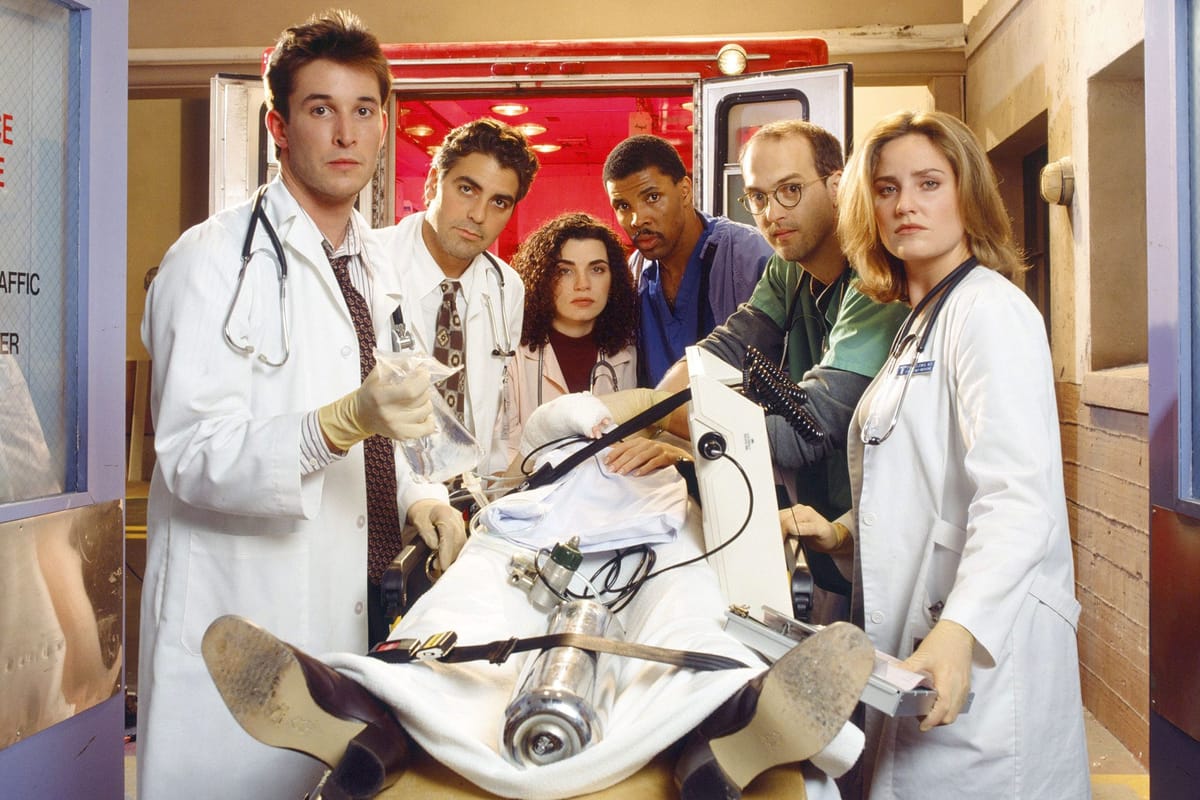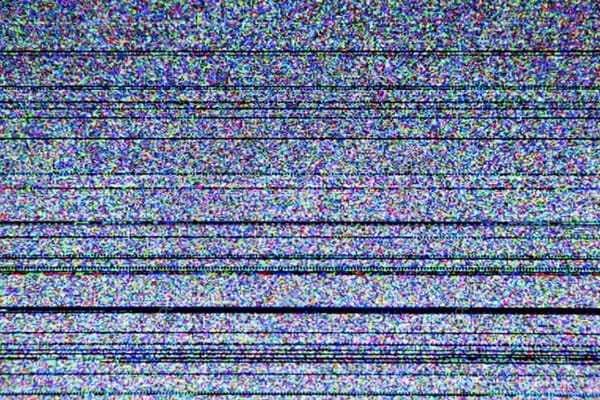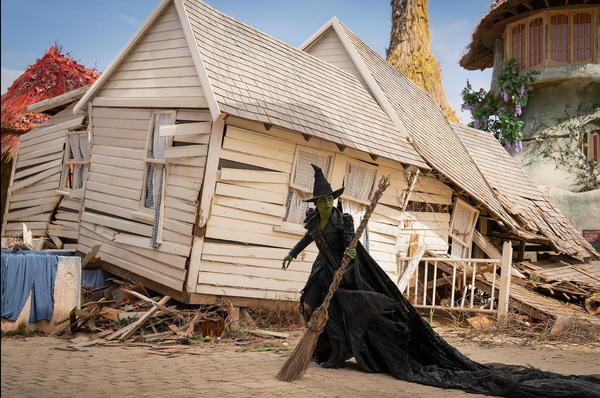Four movements of the workplace drama
In four medical shows

Few TV genres fascinate me more than the humble workplace drama. These are usually shows set in police stations, hospitals, or law firms, though a few have been set in schools, media conglomerates, and political offices. Their height came in the ‘80s and ‘90s — roughly bounded on either end by Hill Street Blues and the first few years of The West Wing — and they have fallen on hard times indeed.
The problem with the workplace drama right now is that it has gone through four separate movements that have subverted something key that came before — but now it’s not immediately clear what can be subverted anymore. I have some thoughts on this, but first of all, let’s define what we mean by “workplace drama.”
The workplace drama is, at its broadest level, any TV drama that takes place primarily in a professional space. If the American sitcom has traditionally been built atop shows about families, while shows about workplaces have often languished, then the American drama is the reverse — workplaces are great; good luck getting people to watch a family drama. The most popular settings for workplace dramas are, as mentioned, police stations, hospitals, and law firms. This is because these three settings offer instant, ready-made life-or-death stakes. The only setting to retain consistent popularity across all of TV history is the police station. The relative popularity of hospital shows and law firm shows waxes and wanes.

What most TV critics (including me) mean by “workplace drama” is the classic version of the form established in 1981’s Hill Street Blues (still, for me, a central show in the TV canon). Here, the workplace becomes the central hub through which an entire world is built. Characters have continuing story arcs, and we follow some of them home to see their personal lives. But the real star is the workplace and the many ways the real world enters and exits its space. Social issues are paramount here, with episodes tackling tricky questions of political and social fracture points, and most episodes still have a single storyline that is wrapped up within that hour’s confines.
So with that in mind, let’s look at what I call the four “movements” of the form via the hospital show.
The first movement is roughly everything pre-Hill Street Blues, and it’s a long series of borderline anthology shows. (Yes, there were programs playing around with serialization and more grounded storytelling here — Lou Grant springs to mind — but Hill Street is still the atom bomb that remakes all of TV in its image.) These were shows where the characters at the workplace were usually more important than the workplace. You didn’t watch Marcus Welby, M.D., to see the medical offices he worked in; you watched that show to watch Marcus Welby confront complicated medical questions and the occasional social issue. (In particular, the series had two blatantly homophobic episodes that were so bad, they were protested at the time, one airing in 1973 and the other in 1974.)
Needless to say, these are “problem of the week” shows, and once the problem is solved, the characters move on to the next one in the next episode. This is not to say these shows have no character development. It is to say that it is secondary to the individual stories told in each and every episode. Shows like NCIS and Criminal Minds aren’t quite this, because they have broader, continuing stories, but they’re closer to this format than any other.
Now we’re to the classical workplace drama, a movement that is mostly confined to the 1980s and 1990s. Every so often, a producer will try a throwback to this type of show, and it almost never does particularly well. (An example that is doing okay is New Amsterdam.) The hospital show in the classical vein is the 1982 to 1988 series St. Elsewhere. It established a template that was heavily influenced by Hill Street, with characters who lived complicated lives, bursts of gonzo humor, and a big willingness to look at social issues.
The classical workplace drama takes as its de facto assumption that the people who work in these places are mostly noble and pure-hearted. They might come into conflict with each other, and they might occasionally have difficult storylines where they do bad things. But at the end of the day, they revert to the mean. They are good, and the institutions are good. The classical workplace drama is a broadly liberal show in the mode of JFK and LBJ, a type of political compass that seems increasingly distant in our day and age, which may be why it’s so hard to make shows like this right now.
But as with all things in life and art, a broadly liberal genre prompted what amounts to a conservative backlash — and not just politically. A form that began to emerge in the ‘90s was the subversive workplace drama. In the medical genre, the most notable example is ER, which took everything you knew about hospital shows and turned it on its ear. The series featured hugely fallible characters, who fucked up all the time. Lots and lots of patients died. And the pace of the show was an attempt to capture how it might actually feel to work in a hospital. Institutions in shows like this are crumbling, but they remain basically good places. But the people who work there might have very dark goals indeed.
I would argue there’s another version of this basic type, the subgenre you might call the workplace soap. (Grey’s Anatomy is the example that jumps readily to mind in the medical genre.) Here, instead of emphasizing the stabs at realism in the more traditional subversive workplace drama, the serialization is focused on, with melodramatic plots that bring characters together and force them apart. But notably, the one example of this sort of show that has actually been wildly successful and acclaimed is Grey’s, which is why I think it more properly belongs here than in its own category.
This brings us to the final movement, which grows out of subversion in the same way subversion grew out of classicism — the antihero workplace drama. These are shows where institutions are actively falling apart, the characters we follow are often terrible people, and we’re invited to consider the knotty complications of actually doing these jobs and seeing how far you might fall. In the medical genre, you might look at House, which is a show with an antiheroic character at its center, but a show that is such a case of the week series that it doesn’t ever really consider inherent problems within society.
So let me submit Nip/Tuck, a kind of workplace soap (since it eventually went completely bonkers) but, in its first two seasons, at least, a show about two plastic surgeons who were in a codependent something or other that kept driving them apart and pushing them back together. Though the show took place in a glitzy space, it was also a forthright critique of Americans’ obsession with youth and beauty.
It’s really hard to keep the antihero workplace drama from going off the rails, because a character has to keep topping themselves to gain the audience’s interest. A show like The Wire (which fits uneasily here but is close enough — it really is simultaneously a classical show, a subversive show, and an antihero show, which is why it’s so rich) managed it, as did The Shield. But shows like Nip/Tuck and Damages got stuck in their own need to make things wilder and wilder.

The natural question, then, to me is what comes next. For a brief moment, I thought ABC’s The Good Doctor represented the way forward — here was an antihero show where the antihero was good, in contrast with the rest of his world, which is at least somewhat realistic. It’s almost as if a superhero has been dropped into a traditional TV setting, complete with the medical skills to prove it. But the “good antihero” series hasn’t seemed to bear much fruit, even though The Good Doctor was a sizable hit for its first season.
A lot of current workplace dramas seem to be trying to do a rough spin on the classical series or the subversive series, but those models long ago ran out of gas. And the borderline anthology is always popular because it’s an endlessly renewable resource.
There have been a lot of gimmick shows, particularly in the cop drama space. These are series where there’s some high-concept idea that drives a lot of the more traditional workplace ideas. Most of them are terrible, but I’d slot Person of Interest here, and it’s wonderful.
I don’t really have an answer to my question of what comes next (which is why I’m writing about this here and not at Vox), but the workplace drama almost always works as a response to a particular political moment. And the particular political moment in most civic-minded workplaces is utter panic at how things are falling apart.
I think Better Call Saul — though not strictly a workplace drama (and an antihero show in any case) — is pretty instructive here. It’s a show about how badly the system is rigged and how little anybody can do to change it. So the answer is to find a way to exist within that system and make it work to your benefit. But because the workplace drama usually is about characters solving problems of the week, a more traditional version of this form might involve them finding ways to manipulate the system to work to the advantage of the guest star of the week. ABC’s Stumptown almost manages this, with its characters navigating various broken systems, but it’s not precisely pushing those ideas to the forefront. (It’s also a private eye show, which is kind of a workplace drama and kind of not.)
Admittedly, a hospital show about navigating the US’s byzantine healthcare system doesn’t sound… all that interesting. But maybe the format is the mission of the week show, where a brave band of daring miscreants work together to save the day because they care so much. What does The A Team look like reimagined as a medical drama? What is Firefly if you set it in a police station? These are questions I’d love to see tackled.
(Another free suggestion: A lot of these ideas would gain tons from being set in poorer communities or rural areas.)
My answer is not perfect, but it feels like somewhere to go. And because these shows tend to be wildly successful, congratulations to you if you figured this out. You’re probably going to make a lot of money.
What I’ve been up to: Listen, I interviewed a time philosopher about why time feels so weird right now, and it’s honestly one of my favorite interviews I’ve ever done. Check it out!
What I really want to stress is the following, by way of prefacing what the data shows on this question: What we call internal time, or subjective time, is very complex. There’s no such thing as one internal clock that we then compare to an external clock. Our brains are these really complex ad hoc systems that are doing a lot of functions at the same time. They’re constantly integrating information and coordinating action.
So what we call our internal clock is actually a whole bunch of internal clocks. We’ve got multiple systems, all of them influencing the subjective perception of time. We’ve got systems just for regulating our bodily functions like our sleep cycle. We’re constantly interpreting and synchronizing multiple sensory modalities — our auditory information has to be integrated into and synchronized with what we’re seeing visually, for example. We’re constantly switching our attention and regulating attention. We’re constantly integrating memories and our anticipations into making plans and performing critical actions.
So there’s a lot of stuff going on all at the same time that all have to do with our internal sense of the passage of time. And with all that complexity, it’s no wonder that sometimes our sense of the passage of time can get weird, under weird circumstances, when we’re in a weird mood.
Read me: I absolutely adore the novel Little Blue Encyclopedia (for Vivian) by Hazel Jane Plante. It’s rare to find great art about trans people and rarer still to find it actually made by us. Plante has written a book that imagines a trans woman mourning her dead friend by assembling an encyclopedia about the (fictional) TV show the two loved, a short-lived prestige drama called Little Blue. Plante understands fandom, and she understands friendship. This is a great, honest book about both.
Watch me: Check out this final number from the NBC show Zoey’s Extraordinary Playlist. Spoilers, I guess, but it was the first time I’d seen anything of the show, and it made me curious to check it out. It’s somehow simultaneously one of the most fascinating things I’ve seen on TV in a while and possibly in incredibly poor taste (sans context). I can’t stop watching it, and I wonder what you’ll make of it.
And another thing… This interactive infographic about the levels of wealth inequality in the world today is a pretty staggering feat of programming and web design, as well as a great way to visualize how much richer the super-rich are than even rich people.
This week’s reading music: “Any Other World” by MIKA
Episodes is published at least once per week and is about whatever I feel like that particular week. Suggest topics for future installments via email or on Twitter. Read more of my work at Vox




